On Dec. 9, 1968, Oregon-born engineer and inventor Douglas Engelbart hosted a computer demonstration so groundbreaking it is known today as the “Mother of All Demos.”
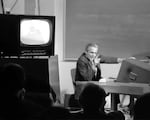
In this screen grab from the 1968 film "Mother of All Demos," Douglas Engelbart demonstrates his revolutionary computer system.
Courtesy of SRI International
Over 1,000 computer and engineering scientists gathered for the 90-minute presentation, watching as Engelbart introduced a working system with many of the computer concepts and tools we use today.
His demonstration included the use of word processing, hypertext, shared screen collaboration, multiple windows, on-screen video teleconferencing and — perhaps most famously — what he called the “computer mouse” because the cord looked like a tail.
The audience had never seen anything like it.

This image from the 1960s shows Douglas Engelbart's original computer mouse. He would later be awarded a U.S. patent for the design.
SRI International
Using computers to solve world problems
Early in his career, Engelbart decided that his life’s work would focus on solving humanity’s problems. He recognized that computers could not only help with that work, but also accelerate it.
At the time, computers solved complex mathematical equations and ran systems based on punch cards. Ordinary people rarely used them, and no one had them in their homes.
Engelbart’s revolutionary ideas changed all of that. He envisioned computers as communication tools that could help people learn, collaborate and tackle complex problems.
“— Douglas Engelbart, 1961Human beings face ever more complex and urgent problems, and their effectiveness in dealing with these problems is a matter that is critical to the stability and continued progress of society.”
Portland and beyond
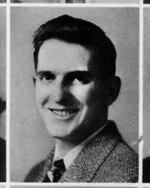
This 1948 Oregon State University yearbook image shows engineering student Douglas Engelbart.
Courtesy of Oregon State University Libraries Special Collections and Archives Research Center
Engelbart grew up on a small farm in Southeast Portland where his father operated a radio store.
He graduated from Franklin High School in 1942 and enrolled at Oregon State College, now called Oregon State University, to study electrical engineering.
When World War II interrupted his studies, he spent two years working as a Navy radio and radar technician in the Philippines.
In a 1986 oral history, Engelbart said the radar training was critical to his later work: “I knew about screens, and how you could use the electronics to shape symbols from any kind of information you had. If there was information that could otherwise go to a card punch or a computer printer, you could convert that to any kind of symbology you wanted on the screen. That just all came from the radar training.”
After the war, he returned to his studies, graduating from OSU in 1948, and would go on to earn a Ph.D. at University of California, Berkeley. By 1959, he founded and directed the Augmentation Research Center at the Stanford Research Institute, where he put his plans into action.
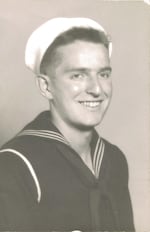
This image from 1945 shows Douglas Engelbart during his time in the U.S. Navy.
Courtesy of the United States Navy
His seminal paper “Augmenting Human Intellect: A Conceptual Framework” outlined innovative ways of manipulating and viewing information, while also sharing it over a network, and allowing multiple people to work together.
“— "Augmenting Human Intellect, Conceptual Framework." Douglas Engelbart, 1962The conceptual framework we seek must orient us toward ... using modern technology to give direct aid to an individual in comprehending complex situations, isolating the significant factors and solving problems.”
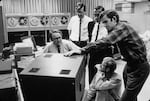
In this image from the 1960s, SRI engineers gather around an early computer system.
Courtesy of SRI International
With his team at SRI, Englebert built a user-friendly hardware and software computer system known as the oN-Line System, or NLS, from the ground up. Its ability to link several users that could work together in real-time formed a proto-intranet.
Father of computer mouse — and much more
In front of 1,000 people, Engelbart unveiled the NLS at the Fall Joint Computer Conference in San Francisco.
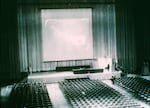
This image from 1968 shows the auditorium where Douglas Engelbart demonstrated his groundbreaking computer technology.
Courtesy of SRI International
Using a 22-foot-high film screen he borrowed from NASA, he projected his computer display so the audience could see what he was doing.
Using a computer mouse, he manipulated text on screen. He typed, deleted, copied and pasted, and moved words around on the page while also resizing windows and hyperlinking between texts.
He then linked in colleagues in another building, putting their live image on the screen in what we know today as video conferencing.
The audience gave him a standing ovation.
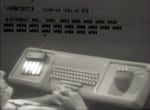
In this image from 1968, Douglas Engelbart demonstrates the use of text on screen, using his revolutionary computer design.
Courtesy of SRI International
For some perspective, in 1968, most people did mathematical calculations on slide rulers. The public wouldn’t be able to buy handheld calculators for another two years.
Engelbart expected his presentation to kick off a new era of computing, attracting talented new engineers to his program. That didn’t happen.
As a Smithsonian article stated on the event’s 40th anniversary, “his ideas were so ahead of their time there was often no language to describe them.”
For the next two decades, Engelbart continued his work at the Stanford Research Institute, now called SRI International. While there, he played a key role in the development of ARPANET, the network that helped set the framework for the Intranet.
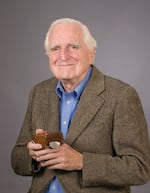
In this image from 2006, Douglas Engelbart poses with his original computer mouse design.
Courtesy of SRI International
Engelbart earned more than 40 awards throughout his lifetime, including the National Medal of Technology and Innovation, the $500,000 Lemelson-MIT Prize and several honorary degrees, including a doctorate from his alma mater, Oregon State University.
Engelbart died in 2013.
Today, Engelbart’s demo is widely recognized as one of the most important events in computer history.

Related: OPB's Oregon Experience: The Spirit of Tek
Related: OPB's Oregon Experience: Oregon State University
